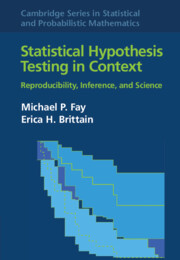Book contents
- Frontmatter
- Contents
- Preface
- 1 Introduction
- 2 Theory of Tests, p-Values, and Confidence Intervals
- 3 From Scientific Theory to Statistical Hypothesis Test
- 4 One-Sample Studies with Binary Responses
- 5 One-Sample Studies with Ordinal or Numeric Responses
- 6 Paired Data
- 7 Two-Sample Studies with Binary Responses
- 8 Assumptions and Hypothesis Tests
- 9 Two-Sample Studies with Ordinal or Numeric Responses
- 10 General Methods for Frequentist Inferences
- 11 k-Sample Studies and Trend Tests
- 12 Clustering and Stratification
- 13 Multiplicity in Testing
- 14 Testing from Models
- 15 Causality
- 16 Censoring
- 17 Missing Data
- 18 Group Sequential and Related Adaptive Methods
- 19 Testing Fit, Equivalence, and Noninferiority
- 20 Power and Sample Size
- 21 Bayesian Hypothesis Testing
- References
- Notation Index
- Concept Index
18 - Group Sequential and Related Adaptive Methods
Published online by Cambridge University Press: 17 April 2022
- Frontmatter
- Contents
- Preface
- 1 Introduction
- 2 Theory of Tests, p-Values, and Confidence Intervals
- 3 From Scientific Theory to Statistical Hypothesis Test
- 4 One-Sample Studies with Binary Responses
- 5 One-Sample Studies with Ordinal or Numeric Responses
- 6 Paired Data
- 7 Two-Sample Studies with Binary Responses
- 8 Assumptions and Hypothesis Tests
- 9 Two-Sample Studies with Ordinal or Numeric Responses
- 10 General Methods for Frequentist Inferences
- 11 k-Sample Studies and Trend Tests
- 12 Clustering and Stratification
- 13 Multiplicity in Testing
- 14 Testing from Models
- 15 Causality
- 16 Censoring
- 17 Missing Data
- 18 Group Sequential and Related Adaptive Methods
- 19 Testing Fit, Equivalence, and Noninferiority
- 20 Power and Sample Size
- 21 Bayesian Hypothesis Testing
- References
- Notation Index
- Concept Index
Summary
This chapter first describes group sequential methods, where interim tests of a study are done and the study may be stopped either for efficacy (if a large enough early treatment effect is seen) or for futility (if it is unlikely that a treatment effect will be significant if the study goes to completion). We compare two methods for group sequential analysis with equally spaced looks, the Pocock and the O’Brien–Fleming methods, both based on the Brownian motion model. Flexible versions of these methods are developed using alpha spending function approach, where the decision to perform an interim analysis may be based on information independent of the study up to that point. We discuss adjustments when the Brownian motion model assumption does not hold, and estimation and confidence intervals after stopping early. Next, we discuss the Bauer–KÖhne and Proschan–Hunsberger two-stage adaptive methods which bound the Type I error rate. These methods partition the study into two stages. The Stage 1 data allows three decisions (1) stop and declare significance, (2) stop for futility, and (3) continue the study with sample size for the second stage based on the first stage data.
- Type
- Chapter
- Information
- Statistical Hypothesis Testing in ContextReproducibility, Inference, and Science, pp. 342 - 358Publisher: Cambridge University PressPrint publication year: 2022



